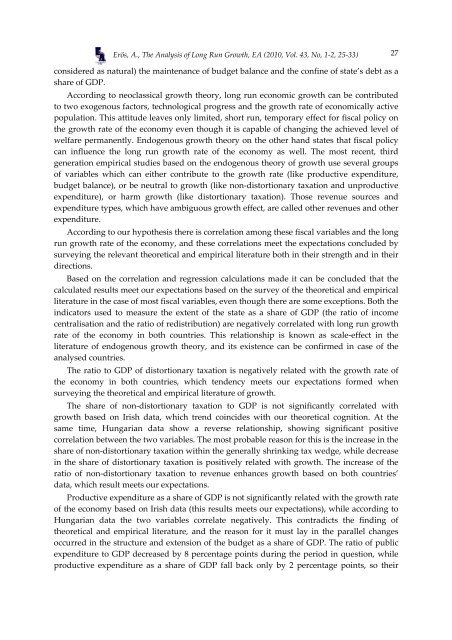Twice a Year Scientific Journal
Twice a Year Scientific Journal
Twice a Year Scientific Journal
Create successful ePaper yourself
Turn your PDF publications into a flip-book with our unique Google optimized e-Paper software.
Erös, A., The Analysis of Long Run Growth, EA (2010, Vol. 43, No, 1-2, 25-33) 27<br />
considered as natural) the maintenance of budget balance and the confine of state’s debt as a<br />
share of GDP.<br />
According to neoclassical growth theory, long run economic growth can be contributed<br />
to two exogenous factors, technological progress and the growth rate of economically active<br />
population. This attitude leaves only limited, short run, temporary effect for fiscal policy on<br />
the growth rate of the economy even though it is capable of changing the achieved level of<br />
welfare permanently. Endogenous growth theory on the other hand states that fiscal policy<br />
can influence the long run growth rate of the economy as well. The most recent, third<br />
generation empirical studies based on the endogenous theory of growth use several groups<br />
of variables which can either contribute to the growth rate (like productive expenditure,<br />
budget balance), or be neutral to growth (like non-distortionary taxation and unproductive<br />
expenditure), or harm growth (like distortionary taxation). Those revenue sources and<br />
expenditure types, which have ambiguous growth effect, are called other revenues and other<br />
expenditure.<br />
According to our hypothesis there is correlation among these fiscal variables and the long<br />
run growth rate of the economy, and these correlations meet the expectations concluded by<br />
surveying the relevant theoretical and empirical literature both in their strength and in their<br />
directions.<br />
Based on the correlation and regression calculations made it can be concluded that the<br />
calculated results meet our expectations based on the survey of the theoretical and empirical<br />
literature in the case of most fiscal variables, even though there are some exceptions. Both the<br />
indicators used to measure the extent of the state as a share of GDP (the ratio of income<br />
centralisation and the ratio of redistribution) are negatively correlated with long run growth<br />
rate of the economy in both countries. This relationship is known as scale-effect in the<br />
literature of endogenous growth theory, and its existence can be confirmed in case of the<br />
analysed countries.<br />
The ratio to GDP of distortionary taxation is negatively related with the growth rate of<br />
the economy in both countries, which tendency meets our expectations formed when<br />
surveying the theoretical and empirical literature of growth.<br />
The share of non-distortionary taxation to GDP is not significantly correlated with<br />
growth based on Irish data, which trend coincides with our theoretical cognition. At the<br />
same time, Hungarian data show a reverse relationship, showing significant positive<br />
correlation between the two variables. The most probable reason for this is the increase in the<br />
share of non-distortionary taxation within the generally shrinking tax wedge, while decrease<br />
in the share of distortionary taxation is positively related with growth. The increase of the<br />
ratio of non-distortionary taxation to revenue enhances growth based on both countries’<br />
data, which result meets our expectations.<br />
Productive expenditure as a share of GDP is not significantly related with the growth rate<br />
of the economy based on Irish data (this results meets our expectations), while according to<br />
Hungarian data the two variables correlate negatively. This contradicts the finding of<br />
theoretical and empirical literature, and the reason for it must lay in the parallel changes<br />
occurred in the structure and extension of the budget as a share of GDP. The ratio of public<br />
expenditure to GDP decreased by 8 percentage points during the period in question, while<br />
productive expenditure as a share of GDP fall back only by 2 percentage points, so their
















